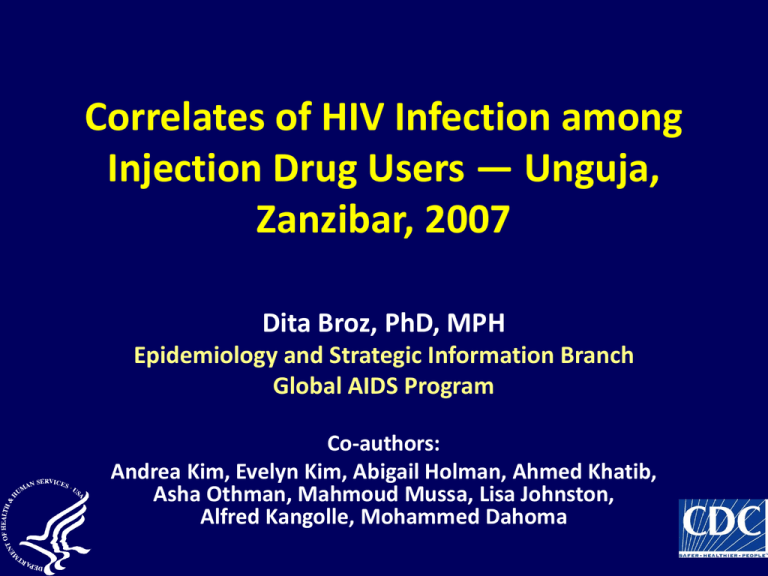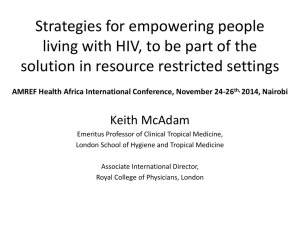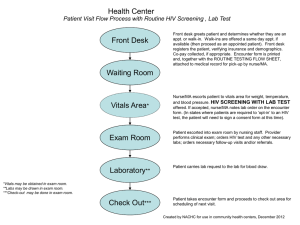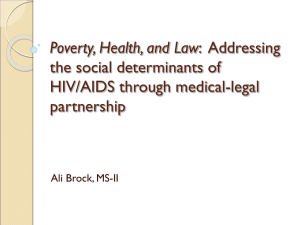
Correlates of HIV Infection among
Injection Drug Users — Unguja,
Zanzibar, 2007
Dita Broz, PhD, MPH
Epidemiology and Strategic Information Branch
Global AIDS Program
Co-authors:
Andrea Kim, Evelyn Kim, Abigail Holman, Ahmed Khatib,
Asha Othman, Mahmoud Mussa, Lisa Johnston,
Alfred Kangolle, Mohammed Dahoma
Background
• HIV in Sub-Saharan Africa*
– 22.4 million
– Heterosexual transmission
– Data on other transmission routes is limited
* UNAIDS HIV Epidemic Update, 2009
2
Injection Drug Use and HIV
• Global estimates of drug injection*
– 16 million injection drug users (IDUs)
– 19% of IDUs living with HIV
• IDUs have increased risk for HIV
– Sharing injection equipment
– High risk sex practices
• HIV transmission to the general population
• IDUs have increased risk for other bloodborne
infections, such as hepatitis C virus (HCV)
3
* Mathers et al, Lancet 2008: 372:1733-45
HIV Epidemic in Unguja
• Unguja, Zanzibar*
– Total population 621,000
– Most reside in rural areas
– 97% Muslim
Unguja
• Adult HIV prevalence is 0.8%†
– 0.9% females
– 0.6% males
• Concentrated HIV epidemic
* Tanzania Population and Housing Census 2002
† Tanzania HIV/AIDS and Malaria Indicator Survey 2007-2008
4
Injection Drug Use in Unguja
• Increase in local drug markets and drug use
• Exploratory study of IDUs in 2005*
– 30% HIV prevalence
– Unsafe injection practices
– Reports of direct blood sharing
*Dahoma et al, African J of Drug & Alc Studies 2006: 5(2):130-139
5
Behavioral and Biological
Surveillance Survey, 2007
Overall Goal:
To provide information on the prevalence of HIV
infection and associated risk factors from a
representative sample of IDUs
Analysis Objectives:
1. Describe socio-demographics and high-risk
behaviors of IDUs
2. Estimate HIV and HCV seroprevalence
3. Assess independent correlates of HIV seroprevalence
6
Survey Design
• August – September, 2007
• Respondent-driven sampling (RDS)
– Probability-based, peer-recruitment sampling
– Designed to sample hard-to-reach populations
• Eligibility
–
–
–
–
Injected drugs in the past 3 months
Age ≥15 years
Lived in Unguja in the past 3 months
Able to provide informed consent
* Heckathorn, Soc Probl 1997: 44:174-99
7
RDS Recruitment
Wave 1 Wave 2 Wave 3 Wave 4 Wave 5
Seed (n=7)
Note: Illustration is created for demonstration purposes only
8
RDS Recruitment
Wave 1 Wave 2 Wave 3 Wave 4 Wave 5
Seed
• Limited number of referrals per subject
• Statistical adjustment based on:
– Social network size
– Recruitment pattern
Note: Illustration is created for demonstration purposes only
9
RDS Recruitment
Wave 1 Wave 2 Wave 3 Wave 4 Wave 5
Note: Illustration is created for demonstration purposes only
10
RDS Recruitment
Wave 1 Wave 2 Wave 3 Wave 4 Wave 5
Note: Illustration is created for demonstration purposes only
11
RDS Recruitment
Wave 1 Wave 2 Wave 3 Wave 4 Wave 5
Note: Illustration is created for demonstration purposes only
12
RDS Recruitment
Wave 1 Wave 2 Wave 3 Wave 4 Wave 5 . . .
N=493
Note: Illustration is created for demonstration purposes only
13
Data Collection
• Behavioral questionnaire
• HIV testing
– Serial 2-test algorithm using rapid HIV tests
– Discordant specimen retested using a 3rd rapid HIV test
• HCV testing
– Rapid test strips for detection of HCV antibody
• Pre- and post-test counseling and referrals for
follow-up care
14
Statistical Analysis
• Descriptive Analysis – RDS Analysis Tool (RDSAT)
– Estimated population proportions
– Adjusted for social network size and recruitment
patterns
• Logistic Regression - SAS
–
–
–
–
HIV seroprevalence weights generated by RDSAT
Univariate and stratified analyses
Multivariable analysis
Odds ratios (OR) and 95% confidence intervals (CI) for
the final model
15
Socio-demographics (N=493)
Selected variables
Median age
n
% (95%CI)*
31 years (range 15-66)
Males
478
96.9 (94.2-98.7)
Completed ≤7 years of education
151
34.4 (28.8-40.6)
Household income <100,000 TZS
(~74 USD), past month
174
42.7 (36.6-48.4)
314
92
59
13
14
64.1 (58.1-70.4)
18.6 (14.3-23.2)
11.4 (7.8-15.8)
4.2 (1.2-7.4)
1.6 (0.6-2.9)
Current living situation
Family
Alone
Spouse/partner
Friends
No stable address
*Proportion estimates and 95% confidence intervals (CI) are adjusted for RDS design
16
Drug Using Characteristics (N=493)
Selected variables
n
% (95%CI)*
Median duration of injecting
10 years (range 1-36)
Injected heroin, past 3 months
491
98.4 (96.8-100.0)
Injected several times per day,
past month
481
97.5 (95.8-99.0)
385
77.4 (72.6-81.8)
328
212
135
187
66.7 (61.2-71.5)
47.4 (41.5-52.4)
38.2 (32.1-46.6)
43.3 (38.1-48.6)
Used non-injecting drugs (other
than alcohol), past 3 months
Marijuana
Powder cocaine
Heroin
Pain killers/prescription drugs
*Proportion estimates and 95% confidence intervals (CI) are adjusted for RDS design
17
High Risk Injection Behaviors (N=493)
Selected variables, past month
n
% (95%CI)*
Shared needles
251
53.4 (47.8-59.0)
Shared needles always/most of the time
162
34.6 (23.9-39.9)
Shared needles with steady sex partner
161
35.3 (29.7-40.9)
Prepared drugs with others using the
same equipment always/most of the time
222
45.5 (39.7-50.5)
Direct blood sharing
22
3.3 (1.5-5.9)
*Proportion estimates and 95% confidence intervals (CI) are adjusted for RDS design
18
Sexual Behaviors (N=493)
Selected variables
n
% (95%CI)*
Sexually active, past month
257
52.7 (46.5-58.8)
Sex with steady partner, past month
189
38.9 (32.9-44.5)
Sex in exchange for money/gifts,
past month
95
26.2 (23.5-30.1)
≥2 sex partners, past month
174
32.4 (27.2-38.0)
Never used condoms, lifetime
175
34.2 (28.8-39.1)
STI symptoms, past 6 months
91
19.2 (14.7-24.0)
STI =sexually transmitted infection symptoms included genital discharge , genital or anal sores
19
*Proportion estimates and 95% confidence intervals (CI) are adjusted for RDS design
HIV and HCV Seroprevalence
95% confidence interval
30%
26.4%
25%
20%
16.1%
15%
43 co-infections
(54.4% of HIV+)
10%
5%
0%
HIV
HCV
20
Multivariable Model of Factors
Associated with HIV Seroprevalence
AOR* (95%CI)
HCV-positive serostatus
3.1 (1.6-6.2)
Never used condoms, lifetime
2.5 (1.3-4.8)
STI symptoms, past 6 months
2.1 (1.1-4.2)
Completed ≤7 years of education
2.2 (1.1-4.4)
* OR’s are adjusted for age, sex and all variables listed in the table
21
Summary of Key Findings
• HIV seroprevalence among IDUs in Unguja,
Zanzibar was high
• Over half of HIV-positive IDUs were co-infected
with HCV
• HCV serostatus was the strongest correlate of
HIV seroprevalence: biomarker of injection risk
• Indicators of high-risk sex behaviors were
associated with HIV seroprevalence
22
Limitations
• Cross-sectional data
– Not able to assess temporality
– Not able to assess directionality
• Self-reported behavioral data
– Potential social desirability bias
– Misclassification
– Unable to assess sexual contact with
non-injecting partners
• Small number of females
23
Public Health Implications
• Need for comprehensive services
– Reduction of injection and sexual risk behaviors
– Strategies to link to treatment and care services
for substance abuse, HIV and other STIs
– Integration of HCV prevention, counseling and
testing
• Routine behavioral and biological surveillance
– Size estimation
24
Acknowledgements
• Survey Participants
• Zanzibar Study Team
• Zanzibar AIDS Control
Programme
–
–
–
–
Mohammed Dahoma
Ahmed Khatib
Asha Othman
Mahmoud Mussa
• Tulane University
– Lisa Johnston
– Leigh Ann Miller
• CDC GAP Atlanta
–
–
–
–
–
–
–
–
Andrea Kim
John Aberle-Grasse
Sanny Chen
Amy Drake
Avi Hakim
Roberta Horth
Evelyn Kim
Janet Lee
–
–
–
–
–
–
–
William Levine
Abraham Miranda
Christopher Murrill
Joyce Neal
Wanjiru Maruiru
Aisha Yansaneh
Irum Zaidi
• CDC Tanzania
– Gilly Arthur
– John Grove
– Irene Benech
– Abigail Holman
– Mary Kibona
– Alfred Kangolle
The findings and conclusions in this presentation are those of the
author(s) and do not necessarily represent the official position of the
Centers for Disease Control and Prevention.
25
Thank you!
26
Programs for IDUs Prior to 2007
• Few IDU prevention programs
– Education campaign by NGOs, Zanzibar Associated of
Information Against Drug Abuse and Alcohol, and
religious leaders
– Peer education/community mobilization
• No specific harm reduction strategies
(e.g., access to sterile equipment, bleach cleaning)
• No substance abuse rehabilitation facilities
• Little focus on MARPs for HIV testing, care and
treatment
27
Current Public Health Practice
• Strategic plans
– Substance Use and HIV/AIDS Strategic Plan 2007-2011
– Minimum Package for HIV Prevention
• Currently implemented or planned programs
–
–
–
–
–
–
Mobile outreach services for HIV and STI testing
Drop-in centers
Sensitization training for health care workers
Distribution of bleach kits
Plans for medication assisted therapy
Plan for hepatitis B and C virus screening and
interventions
28
Substance Use and HIV/AIDS Strategic
Plan 2007-2011
• To reduce HIV/STI infections by 50% by 2011
• Provide treatment care and support to IDUs and their
families
Strategies:
•
•
•
•
•
•
•
Outreach for HIV prevention (risk reduction, HIV testing)
Mobile HIV testing
Community education and media campaign
Links to substance abuse treatment and counseling
Sensitization of health care workers (HCW)
Training of HCW on management of HIV, STI among users
Increase access to HIV care and treatment
29
HIV and HCV Seroprevalence, by sex
Males (n=478)
80%
Females (n=16)
74.0%
70%
60%
50%
39.4%
40%
26.1%
30%
20%
14.2%
10%
0%
HIV
HCV
HIV
HCV
30
Background: Hepatitis C Virus
• Chronic bloodborne infection
• Primary transmission through percutanous
exposure to infectious blood
• Infrequent transmission through sex and MTCT
• HCV as a biomarker of past injection risk
– HCV and HIV have common transmission route
– Injection-related transmission probability 10x
greater for HCV than for HIV
– HCV propagates through injection drug using
populations earlier and quicker than HIV
31
Medical Injections, Unguja
• Medical injection in the past 12 months, 15-49
years old (Unguja)
• Average number of medical injections per
person
– Females 1.0
– Males 0.7
• For last injection, syringe and needle take from a
new, unopened package
– Females 98.8%
– Males 95.4%
32
Blood Transfusion
• As of 2003, all donated blood in Zanzibar are
screened for HIV, HCV, HBV, and Syphilis
• HCV Prevalence in Zanzibar general population
– Blood donor (Zanzibar, 2002): 5.5%
– Pregnant women (Unguja, 2008): 0.2%
• Risk of transfusion-transmitted HCV infections in
Tanzania (1998-2008)
– 678 per 100,000 donations
33
Biological Test Performance
HIV test performance
• SD Bioline, Determine® and Unigold™ all have
100% sensitivity and 99.8% specificity
HIV testing quality assurance
• All positive and 10% of negative specimen retested
using enzyme-linked immunosorbent assay (ELISA)
HCV test performance
• ACON® test strips have sensitivity >99% and
specificity 99.6%
34
Other Biological Testing
• Syphilis
– ACON® Syphilis Ultra Rapid Test for detection of
Treponema pallidum antibodies
– 2 tested positive, 0.3% (95% CI 0.0-0.9)
• Hepatitis B
– ACON® HBsAg virus test strips (surface antigen)
– 29 tested positive, 6.5% (95% CI 3.7-9.8)
35
RDSAT: Homophily
• Mixing patterns in networks
• Probability HIV + person being connected to
another HIV + person, from population HIV + and –
people
• Either positive or negative (-1 to 1)
– Positive homophily: preferential recruit people similar
to self
– Negative homophily: preferential recruitment people
NOT similar to self
– When 0 for all groups: equilibrium and sample
36
proportions identical to RDS population
RDSAT: Equilibrium
• Equilibrium reached for IDU sample
– Assessed key variables: HIV serostatus, age, sex,
duration of injecting, income, education
• Definition: point where proportions for each
variable change minimally regardless of more
participants
• Attaining equilibrium overcomes biases
introduced by non-random seed selection
37
Traditional Probability Sampling
and RDS
POPULATION
POPULATION
Estimation
Collection
Estimation
SAMPLE
Collection
Social
Networ
k
SAMPLE
Estimation
Heckathorn & Salganik, 2002
38
RDS Assumptions
• Participants have well-connected social
networks; connections are reciprocal
• Network is composed of a single component;
connections are dense
• Sampling occurs with replacement
• Respondents can accurately report their social
network size
• Peer recruitment is random
39
Other Methods to Sample Hard-toReach Populations and Biases
Snowball
• Not representative of the target population
Time-Location (TLS), venue-based
• Only captures those who are visible
Institutional sampling
• Not representative of target population
40





